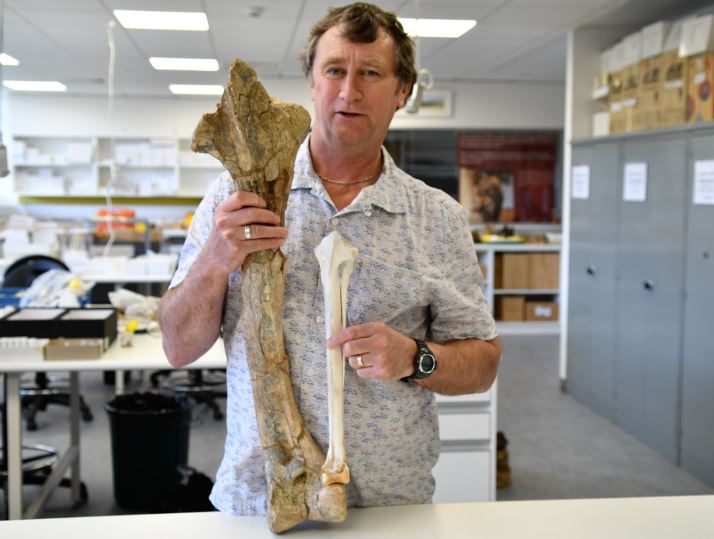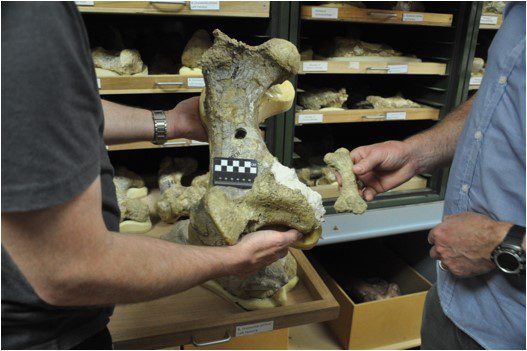Bones of the extinct Dromornis stirtoni, probably the largest bird that ever lived, have revealed the fatal weakness that destroyed their descendants 7 million years later – they took too long to breed.
Before they died out around 50,00 years ago, Australia once hosted birds as much as four times bigger than ostriches, the largest modern avians. Among these, possibly the largest was Dromornis stirtoni. Dromornis were mihirungs, relatives of chickens and ducks that grew to 3 meters (10 feet) tall and weighed 500 kilograms (1,100 pounds), which is why they have been nicknamed “demon ducks of doom”.
A study in the Anatomical Record compares the growth patterns recorded in the bones of D. stirtoni and Genyornis newtoni, the last of the mihirungs to go extinct. Although D. stirtoni grew immensely fast for the first two years, they then slowed down and didn’t achieve breeding size until much later. Genyornis reached its full size earlier, but still inherited the late breeding of its giant ancestor, leaving it with no capacity to deal with the arrival of a new hunter, humans.
Around 8 million years ago Australia had a very different climate, with rainforests in the continent’s heart, Dr Trevor Worthy of Flinders University told IFLScience. These forests supported three species of mihirungs, including the largest, D. stirtoni.

Dr Trevor Worthy with “drumstick” bones from Dromornis, the largest bird that ever lived, and one of its descendants, the emu. Image Credit: Flinders University
Dromornis bones that look like they belong to a dinosaur rather than a mighty duck, from the northern Flinders Ranges and near Alice Springs, were analyzed by Worthy and co-authors for the paper.
“We studied thin sections of the fossilised bones of these thunder birds under the microscope so that we could identify the biological signals recorded within. The microscopic structure of their bones gives us information about how long they took to reach adult size, when they reached sexual maturity, and we can even tell when the females were ovulating,” Professor Anusuya Chinasamy-Turan of the University of Capetown said in a statement.
These reveal D. stritoni didn’t breed until they were 10 years old. By the standards of humans that still seems early, and birds that frequently lived to 60 had plenty of later chances to reproduce. However, the mihirungs eventually found themselves competing with emus, which can breed by the age of two.

It’s hard to believe these bones come from a bird. Image Credit: Flinders University
As the rainforest dried out D. stritoni and two smaller species of mihirungs died out, but their descendants, including Genyornis, still fearsomely big at 240 kilograms, continued to play a big part in Australia’s ecosystem.
“In fact, they persisted together through several major environmental and climatic perturbations,” Worthy said. “However, while Genyornis was better adapted than its ancestors, and survived through two million years of the Pleistocene when arid and drought conditions were the norm, it was still a slow-growing and slow-breeding bird compared to the emu.” Genyornis got to full size within two years, the paper reveals, but still didn’t start breeding for quite a while thereafter.
Such slow breeding is common for species that live in relatively stable environments, like the rainforests from which the mihirungs sprung. It’s more of a problem in the boom-bust climate Australia became, but Genyornis managed nevertheless. Then humans arrived. By about 50,000 years ago, Genyornis was extinct.
The question of whether humans were responsible for the extinction of Australia’s megafauna remains hotly contested. However, in this case, Worthy has no doubts. “Human arrivals would have done three things,” he told IFLScience. “They would have burnt the environment, which would have destroyed a lot of Genyornis’ food, they would have eaten the eggs and they would have hunted them.”
Even if Genyornis was never a primary hunting target, a species that took so long to reproduce would not have been able to recover from even modest losses.
Worthy compared the mihirungs to New Zealand’s kākāpō, which can live for nearly a century, but breeds only every five years or so when their favorite fruit has a big year. Worthy pointed out that, despite their immense popularity, this makes it hard for conservation programs that work on a one-year cycle to support kākāpōs. If any mihirungs had survived, they’d be similarly frustrating to those tasked with keeping the species alive.
Source Link: We May Know What Killed Off Australia’s Giant Extinct “Demon Ducks Of Doom”